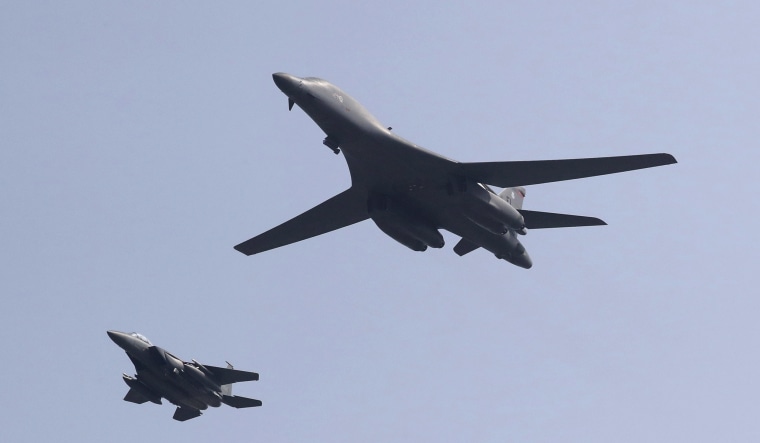Call it gunboat diplomacy from 35,000 feet.
Three times in the last two months, the United States has flown B-1 bombers, equipped with the latest non-nuclear cruise missiles, on missions in Europe and Asia meant to show adversaries as well as allies what one U.S. commander called "an unshakable commitment."
The flights are part of strategic missions aimed at sending explicit messages to Russia, China and North Korea. Each of the B-1s is equipped with two dozen non-nuclear cruise missiles with highly accurate, bunker-busting warheads, a new capability.
“Deployment follows capability,” said Hans M. Kristensen of the Federation of American Scientists, who tracks the missions. He explained that with the Joint Air-to-Surface Standoff Missile (JASSM), a cruise missile, the U.S. believes it has an intimidating, even if non-nuclear, capability.
The latest mission took place Monday night over the Korean peninsula, when two B-1 bombers flew within a few miles of the DMZ between North and South Korea, accompanied by U.S. F-16s and South Korean F-15s. Earlier in the mission, which was flown out of Andersen Air Force Base in Guam, the B-1s were escorted by Japanese F-15's.
The U.S. left no doubt that the flyover was related to North Korea's latest nuclear weapons test, which took place four days ago.
"North Korea's nuclear test is a dangerous escalation and poses an unacceptable threat," Gen. Vincent K. Brooks, U.S. Forces Korea commander, said in a statement Tuesday. "The United States has an unshakable commitment to defend allies in the region and will take necessary steps to do so, including operations like this one today."
And to ensure that no one missed the point, the Defense Department released both still images and video of the mission.
The mission was one of three in recent weeks intended by the U.S. to act as deterrence, but which its adversaries claim are provocations.
On Tuesday, a B-1 bomber from Dyess Air Force Base in Texas landed at Ostrava Air Force Base in the Czech Republic, part of the deployment of a non-nuclear bomber strike group to Europe for exercise Ample Strike, according to official Pentagon reports. The B-1 joined a B-52 that flew to Ostrava two weeks ago.
Kristensen said that while the U.S. had deployed a B-1 to the Czech Republic “on a good will mission” in the past, this is different. “It’s part of a strike package of bombers deployed as part of a NATO exercise,” he said, and as such is more likely to attract Russian attention.
Kristensen also noted that last month, as part of the same NATO exercise, a B-52 was deployed to neighboring Slovakia, also a first as part of an exercise.
Earlier this summer, a B-1 and a B-2 stealth bomber were deployed to Andersen AFB in Guam, from which the Air Force’s venerable B-52 still flies. It marked the first time all three U.S. strategic bombers have been deployed to Asia simultaneously. The Pentagon again left little to the imagination, calling the deployment “Continuous Bomber Presence.”
Then, on August 17, again working with regional allies, the U.S. flew all three bomber types on a mission over the disputed South China Sea, where the People’s Republic of China is trying to assert dominance over islands and sea lanes that U.S. allies like Japan and Philippines also claim.
'A Flood of Reckless Nuclear Attacks'
On Tuesday, the response from North Korea to Monday’s exercise came in a statement from KCNA, the North’s official news agency.
"Any sanction, provocation and pressure cannot ruin our status as a nuclear state and evil political and military provocations will only result in a flood of reckless nuclear attacks that will bring a final destruction," KCNA said.
Related: U.S. 'Should Be Increasingly Worried' About Kim's Nuke Tests
Meanwhile, U.S. military officials tell NBC News that flights by Chinese bombers on Monday were meant as a counter to last month’s U.S. bomber overflights of the South China Sea.
According to a Defense Ministry statement on one of its blogs, on Monday China carried out an exercise in the Bashi Channel, between the Philippines' northernmost island of Luzon and Taiwan. Both countries dispute China's claims in the South China Sea.
“Bombers, fighters, and early warning and aerial refueling aircraft” flew through the channel on Monday, Reuters reported, based on the blog statement. “This move is to raise the air force’s abilities via training, to meet the needs to maintaining national sovereignty, protecting national security and guaranteeing peaceful development.”
In fact, according to a senior Air Force official, this might be the first time in history when the United States, China and Russia are all employing long-range bombers in conventional warfare tasks and deterrence missions.
Russia has repeatedly bombed targets in Syria using long-range bombers, its first combat experience since the war in Chechnya. China has been flying regular patrols in the South China Sea as part of its demonstration of greater military muscle.
All of these aircraft are potentially capable of carrying nuclear weapons, the official said, but this is “conventional deterrence and signaling.” Long-range assets — bombers and missiles — are now on par with nuclear and cyber weapons as elements of the new strategic triad.
Kristensen says much of the U.S. strategy is driven by its recent deployment of the extended-range JASSM missile. Each B-1 can carry up to 24 for them, each with a 1,000-pound penetrating warhead. It reportedly can hit a target 600 miles away with an accuracy of eight feet.
“It’s a significant but little noticed shift,” he said.

